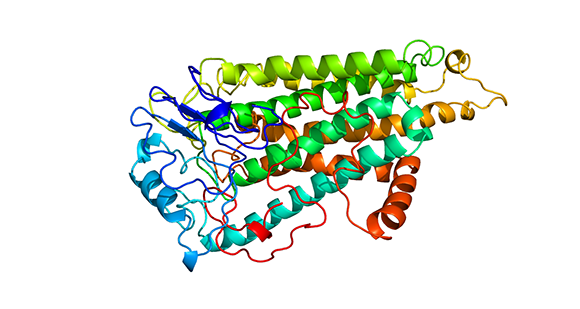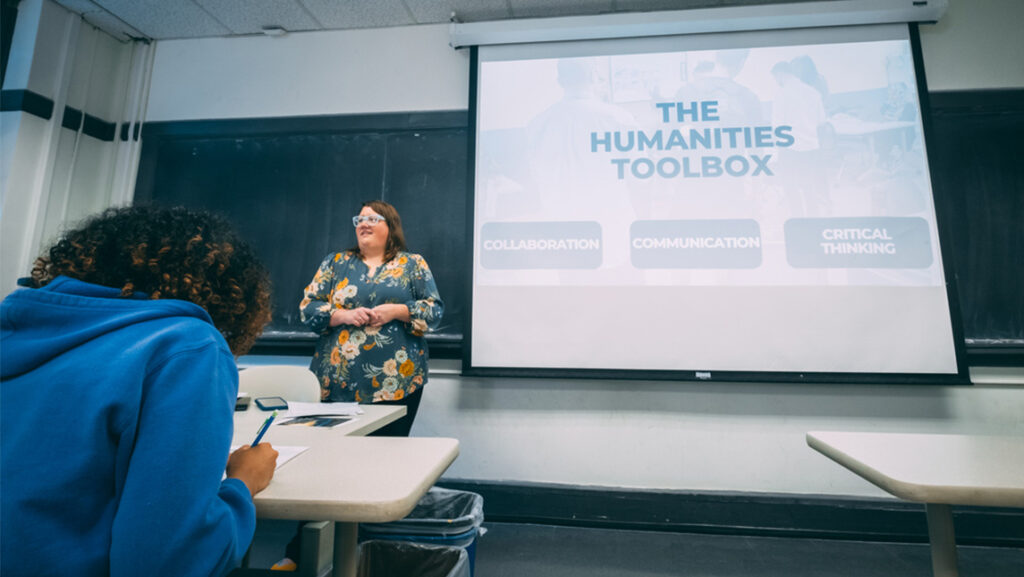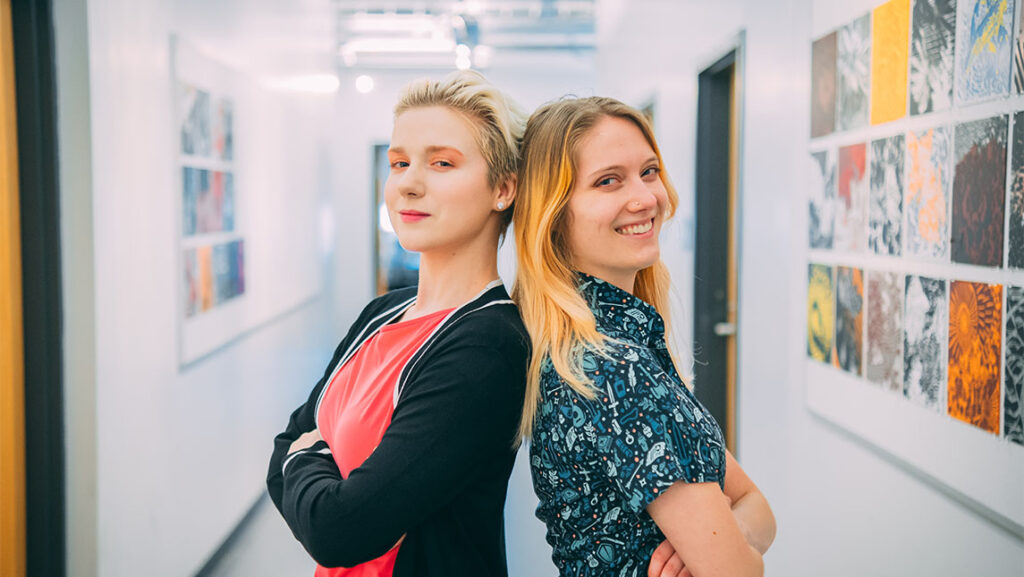excerpt, Fall 2015 UNCG Research Magazine
UNCG scientists are the first in the world to create a compound that targets just one signaling mechanism in cannabinoid receptors (cellular-level structures that influence all sorts of neurological and physical functions).
The discovery could lead to new medicines for treating a wide range of illnesses — glaucoma, chemotherapy-induced nausea, post-traumatic stress syndrome, autoimmune disorders, and more, says Dr. Patricia Reggio, Marie Foscue Rourk Professor of Chemistry.
Reggio is the prime architect of the new compound, which she hopes will unlock a long-standing puzzle about how cannabinoid receptors work and open the door to new medical treatments. But to get there, Reggio is tapping collaborators in France — and their rats.
Researchers need to discover, you see, if the new compound will get the rats high.
Until this point, scientists have been unable to target the cannabinoid receptor without causing psychoactive side effects. The cannabinoid receptor is so named because THC, the active ingredient in marijuana, activates it.
“It’s just an accident that something in a plant hits it,” says Reggio, who heads the UNCG Department of Chemistry and Biochemistry and who has been studying cannabinoid receptors for 30 years.
If researchers could target cannabinoid receptors without causing psychoactive effects, it would open up a whole new arena for drug research. Drug regulators and pharmaceutical manufacturers have been mostly unwilling to explore drugs that use the receptor out of fear of their potential psychoactive effects.
“Marijuana is still illegal in lots of states,” Reggio says. “The Food and Drug Administration has a really hard time approving drugs that hit the cannabinoid receptor because they think the drugs have a high potential for abuse.”
That may be about to change.
Protective mechanism
Cannabinoid receptors are present throughout your body — in your brain, in your immune system, and in many other places. In evolutionary terms they’ve been around a long time and, as such, are present in rats as well as humans. They play a vital role.
“It’s there as a protection mechanism for your brain,” Reggio explains. If synapses start firing too fast, the cannabinoid receptors can calm that down, preventing a kind of brain cell burnout. “I don’t think an organism could survive without them.”
The receptor also affects appetite, nausea, intraocular pressure in the eye, memory, and numerous other functions. That means that any compound that activates the receptor could have therapeutic effects.
A few years ago scientists discovered that the cannabinoid receptor has two signaling mechanisms that can be activated — think of them like biochemical locks. THC activates (or opens) both of them — the beta arrestin mechanism and the G-protein mechanism.
But Reggio and other researchers wondered what would happen if you could design a molecule that activated one signaling mechanism but not the other. Activating just one could provide therapeutic effects without the psychoactive side effects that doom any chance of an FDA approval.
To find out, the team designed a likely compound and ran a three-year-long computer simulation.
The simulation software, run on the high-performance computing cluster the UNCG Department of Chemistry and Biochemistry purchased with a 2009 $311,000 grant from the North Carolina Biotechnology Center, allows the researchers to predict exactly how any potential molecule and the cannabinoid receptor will interact.
This is not a program you could run on your laptop.
The cannabinoid receptor is a big, complicated molecule containing about 5,000 atoms. The simulation calculates what happens when the receptor and a potential new drug interact and, crucially, whether the drug molecule activates only one of the two mechanisms or both.
To understand how it works, the researchers have to look at the cannabinoid receptor as it exists in nature — embedded in the lipid bilayer that forms a cell membrane. A computer simulation of the receptor immersed in a lipid bilayer and surrounded by water molecules must track the positions and potential interactions of about 95,000 individual atoms. The cluster — a collection of computers connected together so they function like a single, super powerful machine — calculates the position of each of these atoms every two femtoseconds.
 The simulation revealed that their compound did indeed activate just one mechanism, the beta arrestin signaling mechanism.
The simulation revealed that their compound did indeed activate just one mechanism, the beta arrestin signaling mechanism.
The achievement is notable because of its medical potential, and also because it’s the first molecule we know of that activates just one signaling mechanism on the cannabinoid receptor. Which brings us to the French rats.
Avoiding the high?
The rats will be injected with the compound and their behavior observed. There are several simple tests the French researchers can do to tell how and if the new molecule is having effects similar to THC.
“When they’re taking cannabinoids they’re not moving around a whole lot,” Reggio summarizes.
If the compound doesn’t display psychoactive effects, the molecule can move to the next stage of research, exploring potential medical applications.
UNCG, through its Office of Innovation Commercialization, has already filed for international patent protection for the compound. The filing is an 18-month stopgap measure that gives researchers enough time to figure out if it’s worth doing further research and worth the time and expense of patent filings in various countries around the world.
UNCG pays the bills for the initial patent filing, usually several thousand dollars, says Staton Noel, director of the university’s Office of Innovation Commercialization. Licensees of the technology would pay for further patent costs.
Calculating commercial potential
Noel is himself a veteran of drug development research, having spent 20 years at pharmaceutical giant GlaxoSmithKline. His job is to review research and decide whether it’s worth university time and money to pursue commercialization.
“My first thoughts were of skepticism, because a lot of companies had tried to move forward with cannabinoids,” he said. Side effects and regulatory barriers have discouraged many drug companies. “In the pharmaceutical industry we were really gun shy of this being a medicinal target.”
Though he was initially skeptical of the new compound, after he reviewed all the information, it was an easy call.
Reggio’s science was solid — something that was relatively easy for Noel to verify thanks to his pharma background — and Reggio already had interest from a French drug company.
It’s not always so simple. Noel’s first step in evaluating a new technology or discovery for commercial potential, he says, is to ask a lot of questions.
“I talk to people in the field,” he says. “Invention is one thing, but innovation is another. There needs to be a commercial pathway. We’re not the ‘office of patenting,’ we’re the Office of [Innovation] Commercialization.”
Noel and his office also do a market analysis to assess the commercial potential and look at other patents — also known as prior art — to see if the technology can be patented in a way that would allow for commercialization.
In many ways, the Office of Innovation Commercialization behaves like an early-stage venture capital funder. If some invention — a new drug, software, or something else — is commercialized and successful, it could represent significant revenue for the university. But not all inventions will be commercial successes.
Future revenue from patent licenses or other commercialization opportunities are split 50-50 between the inventor(s) and the university. Of the university’s share, some of the money goes back to the department and school where the technology was developed. Some goes to Noel’s office, where it’s reinvested in new commercialization efforts.
Medicinal biochemistry at UNCG
Reggio isn’t the first UNCG researcher who has brought potential new drugs to Noel.
Several compounds — fungal metabolites — from the UNCG Natural Products and Drug Discovery Center have been patented, Noel says. They’re derived from plants and fungi, rather than designed from scratch the way Reggio’s molecule was.
“That group has a lot of interesting potential compounds,” Noel says. “Over half of pharmaceutical drugs, I believe, come from natural products. They’re usually very complicated molecules to synthesize. That’s a great starting point for developing further drugs and formulations.”
 In the last decade, UNCG’s efforts to develop new drugs have blossomed. Reggio was recruited to the university 11 years ago in part to launch and nurture the PhD program in medicinal biochemistry in the Department of Chemistry and Biochemistry.
In the last decade, UNCG’s efforts to develop new drugs have blossomed. Reggio was recruited to the university 11 years ago in part to launch and nurture the PhD program in medicinal biochemistry in the Department of Chemistry and Biochemistry.
The department has acquired critical equipment for doing drug development research, including two nuclear-magnetic resonance spectrometers, several mass spectrometers, the high-performance computing cluster, and other equipment.
“Chemistry’s really expensive, and it’s because of all these instruments that it’s so expensive,” Reggio says.
But, as her work and that of other UNCG chemists demonstrates, that investment is paying off.
by Mark Tosczak
See the original article and more in the the Fall 2015 UNCG Research Magazine.




